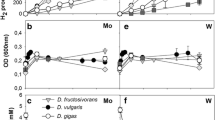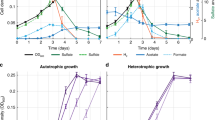Abstract
In a mineral medium containing sulfate, the sulfate-reducing bacteriumDesulfovibrio sp. strain JJ degraded 1 mol of fructose stoichiometrically to 1 mol of H2S, 2 mol of acetate, and presumably 2 mol of CO2. The doubling time was 10 h, and the yield was 41.6 g dry weight/mol fructose degraded. In the absence of sulfate, the hydrogenophilic methanogenMethanospirillum hungatei replaced sulfate as hydrogen sink. In such cocultures, 1 mol of fructose was converted to acetate, methane, succinate, and presumably CO2 in varying concentrations. The growth yield of the H2-transferring association was 33 g dry weight/mol fructose. In the absence of sulfate,Desulfovibrio strain JJ slowly fermented 1 mol of fructose to 1 mol of succinate, 0.5 mol of acetate, and 0.5 mol of ethanol. The results are compared with those of other anaerobic hexose-degrading bacteria.
Similar content being viewed by others
Literature Cited
Akagi JM, Jackson G (1967) Degradation of glucose by proliferating cells ofDesulfotomaculum nigrificans. Appl Microbiol 15:1427–1430
Badziong W, Thauer RK (1978) Growth yields and growth rates ofDesulfovibrio vulgaris (Marburg) growing on hydrogen plus sulfate and hydrogen plus thiosulfate as sole energy source. Arch Microbiol 117:209–214
Bryant MP, Campbell LL, Reddy CA, Crabill MR (1977) Growth ofDesulfovibrio in lactate or ethanol media low in sulfate in association with H2-utilizing methanogenic bacteria. Appl Environ Microbiol 33:1162–1169
Cord-Ruwisch R (1985) A quick method for the determination of dissolved and precipitated sulfides in cultures of sulfate-reducing bacteria. J Microbial Methods 4:1–13
Cord-Ruwisch R, Garcia JL (1985) Isolation and characterization of an anaerobic benzoate degrading spore-forming sulfate reducing bacterium,Desulfotomaculum sapomandens sp. nov. FEMS Microbiol Lett 29:325–330
Cord-Ruwisch R, Ollivier B (1986) Interspecific hydrogen transfer during methanol degradation bySporomusa acidovorans and hydrogenophilic anaerobes. Arch Microbiol 144:163–165
Horder W, Van Dijken JP (1976) Theoretical considerations on the relations between energy production and growth of methane utilizing bacteria. In: Schlegel HG, Gottschalk G, Pfennig N (eds) Microbial production and utilization of gases. Goettingen: Goltze, pp 403–418
Hungate RE (1950) The anaerobic mesophilic cellulolytic bacteria. Bacteriol Rev 14:1–49
Hungate RE (1969) A roll tube method for cultivation of strict anaerobes. In: Norris JB, Ribbons DW (eds) Methods in microbiology, vol 3B. New York: Academic Press, pp 117–132
Jones WJ, Guyot JP, Wolfe RS (1984) Methanogenesis from sucrose by defined immobilized consortia. Appl Environ Microbiol 47:1–6
Jorgensen BB, Fenchel T (1974) The sulfur cycle of a marine sediment model system. Marine Biol 24:189–201
Klemps R, Cypionka H, Widdel F, Pfennig N (1985) Growth with hydrogen, and further physiological characteristics ofDesulfotomaculum species. Arch Microbiol 134:203–207
Loveley DR, Klug MJ (1983) Sulfate reducers can outcompete methanogens at freshwater concentrations. Appl Environ Microbiol 45:187–192
Macy JM, Snellen JE, Hungate RE (1972) Use of syringe methods for anaerobiosis. Am J Clin Nutr 25:1318–1323
Nethe-Jaenchen R, Thauer RK (1984) Growth yields and saturation constant ofDesulfovibrio vulgaris in chemostat culture. Arch Microbiol 137:236–240
Odom JM, Peck, HD Jr (1981) Hydrogen cycling as a general mechanism for energy coupling in the sulfate reducing bacteriaDesulfovibrio sp. FEMS Microbiol Lett 12:47–50
Ollivier B, Cord-Ruwisch R, Lombardo A, Garcia JL (1985) Isolation and characterization ofSporomusa acidovorans sp.nov., a methylotrophic homoacetogenic bacterium. Arch Microbiol 142:307–310
Peck HD Jr (1984) Physiological diversity of the sulfate reducing bacteria. In: Strohl WR, Tuorinen OH (ed) Microbial chemoautotrophy. Columbus: Ohio State University Press, pp 310–335
Peck HD Jr, Odom JM (1984) Hydrogen cycling inDesulfovibrio: a new mechanism for energy coupling in anaerobic microorganisms. In: Microbial mats: stromatolites. New York: AR Liss, pp 215–243
Postgate JR (1984) The sulfate-reducing bacteria. Cambridge: Cambridge University Press
Sansone FJ, Martens CS (1981) Methane production from acetate and associated methane fluxes from anoxic coastal sediments. Science 211:707–709
Sleytr K, Adam H, Klaushofer H (1969) Die Feinstruktur der Zellwand und Cytoplasma-Membran vonClostridium nigrificans dargestellt mit Hilfe der Gefrieraetz- und Ultraduennschicht-Technik. Arch Mikrobiol 66:40–58
Sorensen J, Christensen D, Jorgensen BB (1981) Volatile fatty acids and hydrogen as substrates for sulfate reducing bacteria in anaerobic marine sediments. Appl Environ Microbiol 42:5–11
Tschech A, Pfennig N (1984) Growth yield increase to caffeate reduction inAcetobacterium woodii. Arch Microbiol 137:163–167
Widdel F (1980) Anaerober Abbau von Fettsaeuren und Benzoesaeure durch neu isolierte Arten Sulfat-reduzierter Bakterien. Thesis, University of Göttingen
Widdel F (1984) Sulfate-reducing bacteria and their ecological niches. In: Barnes HG (ed) Anaerobic bacteria in habitats other than man. Oxford. Blackwell
Widdel F, Pfennig N (1984) Dissimilatory sulfate- or sulfurreducing bacteria. In: Krieg NR, Holt JG (eds) Bergey's manual of systematic bacteriology. Baltimore Williams and Wilkins, pp 663–679
Winter JU, Wolfe RS (1980) Methane formation from fructose by syntrophic associations ofAcetobacterium woodii and different strains of methanogens. Arch Microbiol 124:73–79
Author information
Authors and Affiliations
Rights and permissions
About this article
Cite this article
Cord-Ruwisch, R., Ollivier, B. & Garcia, JL. Fructose degradation byDesulfovibrio sp. in pure culture and in coculture withMethanospirillum hungatei . Current Microbiology 13, 285–289 (1986). https://doi.org/10.1007/BF01568654
Issue Date:
DOI: https://doi.org/10.1007/BF01568654




